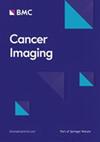基于深度学习的肺癌患者转移检测,提高磁共振成像脑转移筛查的可重复性并减少工作量:一项多中心研究
IF 3.5
2区 医学
Q2 ONCOLOGY
引用次数: 0
摘要
目的:评估基于深度学习的脑转移(BM)黑血成像系统(DLS)能否改善多中心环境下的诊断工作流程。在这项回顾性研究中,对 101 名患者开发了 DLS,并对来自两家三级大学医院的 264 名连续新发脑转移患者(肺癌)进行了验证,这两家医院在 2020 年 1 月至 2021 年 4 月期间进行了黑血成像。四名神经放射科医生在临床试验成像管理系统(CTIMS)上使用提供(有 DLS)或未提供(无 DLS)的分段掩膜和 BM 计数独立评估 BM。为评估读片的可重复性,使用一致性限值(LoA)计算读片者与参考标准之间的 BM 计数一致性。读片时间是 CTIMS 自动测量的,读片者的工作量通过读片时间进行评估,并使用线性混合模型(考虑成像中心)对有 DLS 和无 DLS 的读片者进行比较。在验证队列中,DLS 的检测灵敏度和阳性预测值分别为 90.2%(95% 置信区间 [CI]:88.1-92.2)和 88.2%(95% CI:85.7-90.4)。未使用 DLS 时,读数与参考计数之间的差异(LoA:-0.281,95% CI:-2.888,2.325)大于使用 DLS 时(LoA:-0.163,95% CI:-2.692,2.367)。无论在哪个成像中心,使用 DLS 组的读取时间都从平均 66.9 秒(四分位数间距:43.2-90.6)缩短至 57.3 秒(四分位数间距:33.6-81.0)(P <.001)。在多中心验证中,基于深度学习的黑血成像 BM 检测和计数提高了可重复性,缩短了读取时间。本文章由计算机程序翻译,如有差异,请以英文原文为准。
Deep learning-based metastasis detection in patients with lung cancer to enhance reproducibility and reduce workload in brain metastasis screening with MRI: a multi-center study
To assess whether a deep learning-based system (DLS) with black-blood imaging for brain metastasis (BM) improves the diagnostic workflow in a multi-center setting. In this retrospective study, a DLS was developed in 101 patients and validated on 264 consecutive patients (with lung cancer) having newly developed BM from two tertiary university hospitals, which performed black-blood imaging between January 2020 and April 2021. Four neuroradiologists independently evaluated BM either with segmented masks and BM counts provided (with DLS) or not provided (without DLS) on a clinical trial imaging management system (CTIMS). To assess reading reproducibility, BM count agreement between the readers and the reference standard were calculated using limits of agreement (LoA). Readers’ workload was assessed with reading time, which was automatically measured on CTIMS, and were compared between with and without DLS using linear mixed models considering the imaging center. In the validation cohort, the detection sensitivity and positive predictive value of the DLS were 90.2% (95% confidence interval [CI]: 88.1–92.2) and 88.2% (95% CI: 85.7–90.4), respectively. The difference between the readers and the reference counts was larger without DLS (LoA: −0.281, 95% CI: −2.888, 2.325) than with DLS (LoA: −0.163, 95% CI: −2.692, 2.367). The reading time was reduced from mean 66.9 s (interquartile range: 43.2–90.6) to 57.3 s (interquartile range: 33.6–81.0) (P <.001) in the with DLS group, regardless of the imaging center. Deep learning-based BM detection and counting with black-blood imaging improved reproducibility and reduced reading time, on multi-center validation.
求助全文
通过发布文献求助,成功后即可免费获取论文全文。
去求助
来源期刊

Cancer Imaging
ONCOLOGY-RADIOLOGY, NUCLEAR MEDICINE & MEDICAL IMAGING
CiteScore
7.00
自引率
0.00%
发文量
66
审稿时长
>12 weeks
期刊介绍:
Cancer Imaging is an open access, peer-reviewed journal publishing original articles, reviews and editorials written by expert international radiologists working in oncology.
The journal encompasses CT, MR, PET, ultrasound, radionuclide and multimodal imaging in all kinds of malignant tumours, plus new developments, techniques and innovations. Topics of interest include:
Breast Imaging
Chest
Complications of treatment
Ear, Nose & Throat
Gastrointestinal
Hepatobiliary & Pancreatic
Imaging biomarkers
Interventional
Lymphoma
Measurement of tumour response
Molecular functional imaging
Musculoskeletal
Neuro oncology
Nuclear Medicine
Paediatric.
 求助内容:
求助内容: 应助结果提醒方式:
应助结果提醒方式:


